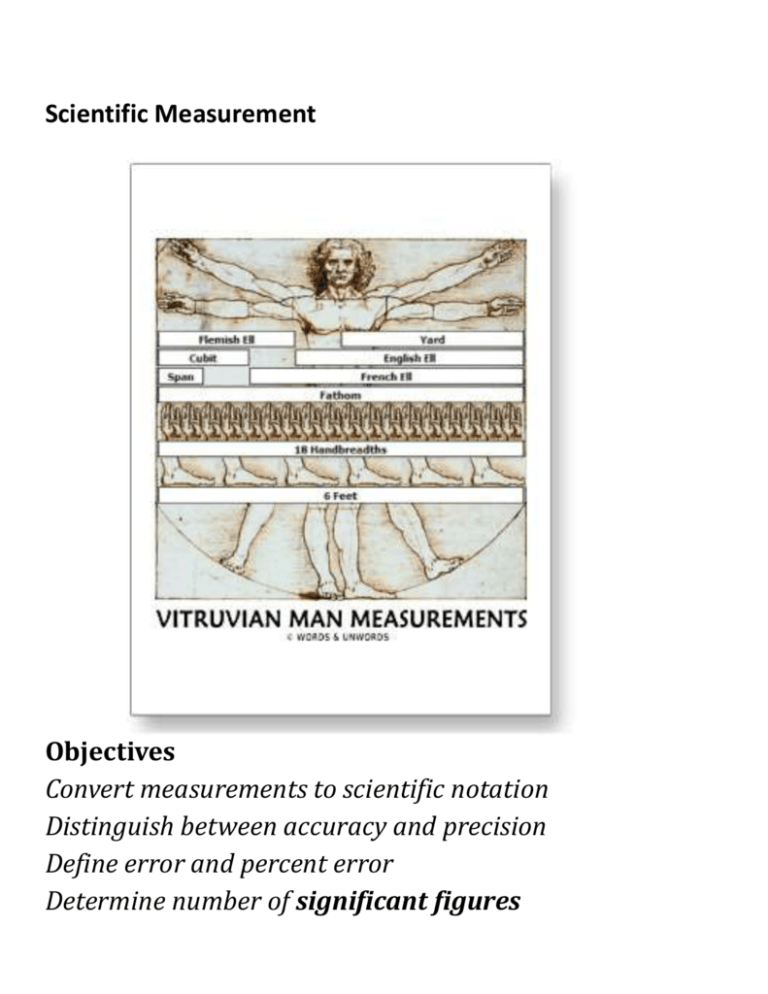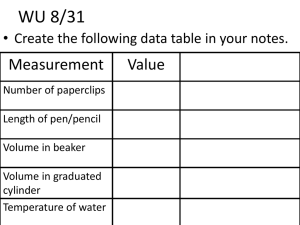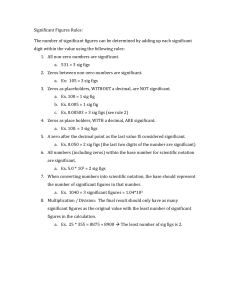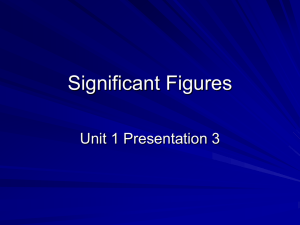metric system , sig figs
advertisement

Scientific Measurement Objectives Convert measurements to scientific notation Distinguish between accuracy and precision Define error and percent error Determine number of significant figures Describe history of Metric System List SI measurements and common prefixes Convert units using dimensional analysis Solve problems by breaking into steps 1. Measurement: quantity that has number and unit. 2) Scientific notation: coefficient X base raised to an exponent Rules for Scientific Notation coefficient = number that is ≥ 1 and <10 base = 10 exponent = number of places decimal is shifted. 4) Accuracy = how close measurement is to true value 5) Precision = repeatability, how close series of measurements are to each other 7) Accepted value =AV= “true value” , standard value 8)Experimental value = EV =lab measurement 9) Error = EV – AV =experimental value – accepted value 10) Percent error = [EV-AV] X 100% AV 11) Percent error is a number NOT a measurement. [a number has no units] 12) Remember to use the absolute value of the error Significant figures 13) Significant figures are numbers that are known with some degree of reliability 14) The last figure in a measurement is the estimated figure. 15) Rules for sig figs: a) All nonzero figs ARE significant b) Zeros between sig figs ARE significant c) Leading zeros in decimals are NOT significant. They are space holders d) Trailing zeros following a decimal OR followed BY a decimal ARE significant e) Trailing zeros NOT followed by a decimal are NOT significant f) Exact numbers have unlimited sig figs. g) All numbers in coefficient in scientific notation ARE significant. h) moving the decimal point does NOT change the number of sig figs 16) taking measurements: “ ½ the least count” If a balance measures in grams, estimated figure is ½ gram 17) Calculations using sig figs: a) A calculated number is precise as the least precise measurement. b) The quantity with the fewest number of measured sig figs determines the sig figs in any calculation. c) Round off a calculation once, at the end of a problem, not at every step. 18) Rules for rounding off: a) b) c) d) decide how many sig figs look at next figure that follows if that figure is ≥ 5 round up but if is < 5 truncate. 19) Addition and subtraction: answer rounded off number of decimal places of measurement with fewest decimal places 20)Multiplication and division: answer has same number of sig figs as component with fewest sig figs. 21) US has been slowly adopting metric system since 1893. History of Metric System 22) Measurements based upon natural world. 23) unit of length = meter = 1m. 24) 1 meter = 1/10,000,000 distance from North Pole to Equator. 25) Centigrade or Celsius : based upon water. 0oC = freezing point , 100oC = boiling point 26) kilogram = unit of mass, based upon water. 27) one kilogram of water occupies 1 liter. 28) 1 liter = 0.1m X0.1m X 0.1m= 1X10-3 m3 29) we will always use MKS Meters – Kilograms-Seconds 30) prefixes are multiples of 10. 31) convert units using factor label method Name Symbol Giga G Mega M Kilo k Base units: meter , liter , gram , - - - sec Deci d Factor 10 10 10 9 6 3 0 10 = 1 10 -1 Centi c Milli m Micro m nano n Pico p 10 10 10 10 -2 -3 -6 -9 -12 10 32) Using the table: the factor tells you how many prefix units are equal to 1 base unit. -9 33)Examples: 1 nanometer = 1 nm = 10 meters 34) use the table to write a ratio between a base unit and a prefix unit Multiply straight across and cancel the units 35)example: 260 mm = ? Meters -2 260 mm X 10 meter = 2.6 m 1 mm 36) Multiple step conversions prefix1 → base→prefix2







